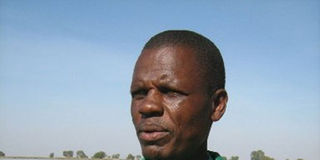Garbage millionaire bags innovation award

George Kanyi Kuria. Photo/FILE
What you need to know:
- Former street boy wins Sh3 million prize for turning town dumpsite into a model horticultural farm
Whenever a toilet flushes in Nanyuki town, Mr George Kanyi counts a few more coins in his pocket.
But the 50-year-old’s fortunes from working on the familiar grounds of a reclaimed garbage dumpsite could well have taken quite a different turn were it not for his remarkable innovativeness.
As a boy, Kanyi scavenged for food at garbage dumpsites in town together with other street children.
Along the way, he had a lucky encounter with a senior military officer who offered to rehabilitate him.
Mr Stephen Njung’e, the then commander of the Laikipia Airbase, hired young Kanyi to cut grass on the edges of the runway and allowed him to sell it to pastoralists and keep 70 per cent of the profit for himself.
Farming business
Later, Kanyi returned home and sold his family’s most precious possession — a plot in Nanyuki town — and used the money to start a small farming business.
In 2007, Mr Kanyi struck a deal with Nanyuki Water and Sanitation Company (Nawasco) to reclaim a garbage dumpsite.Using recycled sewage, he has turned the place into a vibrant horticultural production centre.
His enterprise is partly credited with helping to stabilise vegetable prices in Nanyuki town.
But his highest point came on July 5 when the National Environment Trust Fund ushered him into the millionaires’ club in recognition of his efforts to rehabilitate the dumpsite.
The organisation declared Mr Kanyi the winner of its prestigious Presidential Green Award
The award came with a Sh3 million cheque. Created under the Environment Management Coordination Act 1999, the award is an incentive for good governance and innovative environmental management practices.
Mr Kanyi’s horticultural project employs 12 people on a permanent basis and scores of others, mainly former street children, as casual labourers.
Recycling process
Nawasco technical manager Kennedy Gitonga says about 1,800 cubic metres of raw sewage is discharged into the firm’s systems every day. The effluent goes through a biological recycling process.
Mr Kanyi uses the recycled water to irrigate about 50 acres of land to grow various horticultural crops and fodder.
“Before coming here the whole area was littered with waste. The place did not have a fence and waste paper would be blown to the neighbouring estate making it uninhabitable,” he said.
It took eight months for the water company to accept Mr Kanyi’s proposal. Meanwhile garbage continued to pile up over a large area, and it became a nuisance, especially to the residents of the neighbouring Kilimo estate.
Many of them sold their plots at throw-away prices and left the area. Venturing into the area was also risky due to the presence of street boys.
According to the agreement with Nawasco, Mr Kanyi was to collect the waste and rehabilitate the area for free.
In return, he would be given user rights to the 70 acres of land that are not covered by the sewerage ponds for 10 years. The immediate challenge was how to remove the homeless youths who lived in the area.
“The area was dangerous and mugging and raping of women were commonplace. I had to look for a way to remove the street boys who had erected shelters all over,” he recalls.
He rented rooms in the estate and persuaded the youth to move in in return for employment at the dumpsite.
After two years, the youth would form a formidable team that collected garbage that was scattered all over. They also ensured that garbage trucks dumped their cargo at a designated corner of the site.
“My wife would hear none of it. For the two years that we were collecting the garbage she thought I was crazy. Now she has changed her mind,” Mr Kanyi said.
He started off by planting grass in the area, which he would harvest after every three months to make hay. He produced between 800 and 2,000 bales of hay per harvest.
“After two years I realised that too many people had moved to the hay production business and I decided to shift to horticulture,” recalls Mr Kanyi.
He has since turned the one-time wasteland into a vibrant model horticultural centre. University students, farmers, schools and others regularly visit the farm to learn.
In addition to growing cabbages, lettuce, eggplants and cucumbers, Mr Kanyi rears more than 1,000 rabbits and keeps bees. “There is no time I will ever lack water to irrigate the land even during the dry season,” he says.




